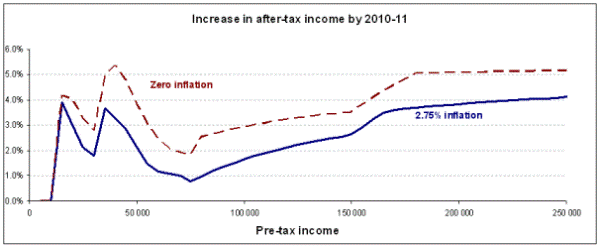On reading the media hype one may believe that the Coalition's proposed $34 billion tax cuts are a radical new policy initiative. But, once inflation is taken into account, they are quite modest. And, as Ben Eltham in NewMatilda.com’s PollieGraph, has pointed out, while acknowledging the benefits of the increase in the low income tax offset (LITO), he finds them to be generally regressive.
At first sight, the cuts seem attractive, particularly for people with low incomes. Those with pre-tax incomes between $35,000 and $45,000 should be receiving around a net 5 per cent pay boost by the time the cuts are fully implemented in 2010-11, and those with very low incomes will get a boost from a more generous LITO.
That’s before we take inflation into account, however.
Advertisement
If we assume an annual inflation of 2.75 per cent (the current Treasury estimate), and generously assume that all incomes will rise with inflation, the rises are far more modest for low income earners. They are down to 3 per cent in real terms for these groups, and, for average income earners (in the $60,000 range) they are only 1 per cent.
The big winners are those with very high incomes (above $200,000) who will enjoy rises of 5 per cent without inflation and still a generous 4 per cent with 2.75per cent inflation. The effects are shown in a graph below, and a full model is in an interactive spreadsheet (Excel format) into which the reader may insert his or her own inflation estimates (and simulate the effect of incomes remaining at present levels without inflation compensation).

The assumption of 2.75 per cent inflation is conservative. Rising energy and food prices, capacity constraints, skills shortages, and the eventual end of price falls for Chinese imports will all feed into Australian inflation. Those on very low incomes are already experiencing price rises well ahead of official measures; they have the burden of higher food, energy, health care and education costs, and higher interest rates, without necessarily enjoying the offsetting benefits of price falls in new cars, foreign travel and electronic goods.
Also, it’s doubtful whether those on low incomes will have the bargaining power to keep their incomes abreast of inflation - a loss of bargaining power which is one of the consequences of WorkChoices.
The Coalition’s guiding theory is that tax cuts will attract people back into the labour force — they correctly point out that Australia has low labour force participation. But has the Coalition considered the alternative of ensuring that there is a more generous floor in our wages? Allowing employers to pay low wages, while supplementing incomes with tax breaks, is, in effect, a subsidy to business, and it provides no incentive for firms to invest in skills or otherwise to improve the productivity of low-paid workers.
Advertisement
At the other end of the scale, the Coalition is possessed by a belief that those who already have high incomes will be attracted to work more by even higher incomes. But labour market economists know that there is an offsetting incentive — once we are well off, we may decide that we can take a little more leisure. A less stressful and lower-paid job, a switch from full-time to part-time employment, or early retirement, may be made possible by a tax cut.
In any event, do Australians want income tax cuts? Over the last 15 years, as our public services have deteriorated, there is strong evidence that our attitudes to the choice between tax cuts and public goods have changed. Tax cuts may be fine but only if our income is secure, and if they aren’t absorbed in higher school fees or health care costs as governments cut into public expenditure.
Labor could do well to take on the Coalition’s changes in the LITO arrangements, but not as a tradeoff for lower wages. And it should be possible to quarantine the LITO to income earned from real economic activity — income from wage employment or genuine business income involving personal exertion. At the top end there is no need for cuts.
With the savings from such conservatism it should be possible to improve Australians’ social wage in health care, education and housing where there are real needs.